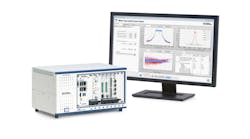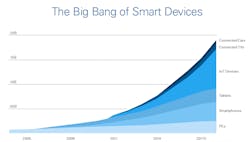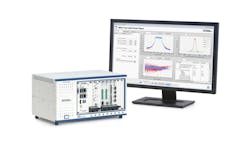With systems accelerating up the curve of smarter and faster with more integrated functionality, you have to at some point decide whether a dedicated point solution with multiple pieces of expensive equipment is really worth the investment. Instead, you may be better off with a more flexible, programmable option that may initially seem like overkill—and may require learning a programming interface—but provides scalability and flexibility as your needs change.
And let there be no doubt about it: Needs are changing. Devices are getting smarter as the Internet of Things (IoT) mandates more processing and communication capability. At the same time the IoT is putting the onus upon designers to make devices smaller and provide them with greater functionality that may need to be updated in the field many times before the next iteration of the device makes it to market (Fig. 1).
Good examples of devices that fit this description are the Nest thermostat; automobiles like the Tesla; smart, sensor-laden airplane models to accelerate build and validation; and RF devices with multiple amplifiers, filtering, switching, power management, and analog-to-digital and digital-to-analog converters.
According to Adam Foster, senior product marketing manager for automated test systems at National Instruments, each of these devices presents its own set of test issues—from small size and changing software in the case of the Nest, to wide bandwidth and high performance to perform digital pre-distortion (DPD) to optimize the output of the power amplifiers. “Tesla ships the best car they can at the time, and the test system is pretty amazing [with respect to] functional safety,” he said.
NI’s platform approach, based on PXI with FPGAs programmed using LabVIEW, is Foster’s suggestion, based on the belief that, “The customer is the smartest piece of test equipment.” This translates to putting as much flexibility and horsepower in the hands of the user as possible, and let them come up with the solution they need, armed with LabVIEW’s relatively easy-to-use graphical user interface to program it.
To help with this, NI introduced the first vector signal transceiver (VST) at its annual NIWeek event in 2012. The VST combined a vector signal generator (VSG) with a vector signal analyzer (VSA). Since then, other VSTs have gone to market, such as Keysight Technologies’ VXT M9420A and Cobham AvComm’s AXIe VST. Cobham’s announcement included a software partnership with NordiaSoft to include support for Software Communications Architecture (SCA), which is intended specifically for enabling software-defined radio design.
Not to be outdone, and cognizant of its own large ecosystem (1,000 partners, 700 field engineers, and 300,000 online users), NI will use its upcoming NIWeek event to showcase the just-announced, second-generation VST, the PXIe-5840 module—the first 1-GHz-bandwidth VST—for the most challenging RF design and test applications, which includes software radio (Fig. 2).
According to David Hall, principal marketing manager for RF and wireless at NI, one of the main drivers for the new VST was the new ITU guidelines on enhanced mobile broadband, along with the need for massive machine-to-machine, ultra-reliable communications—including LTE-M and, of course, 5G (in whatever form it eventually takes).
To handle the next generation of systems, the new PXIe-5840 VST’s features include:
- Support for high-speed serial, making a total of five instruments, if you include the FPGA along with the VSG, VSA, and high-speed parallel support.
- An increase in bandwidth from 200 MHz to 1 GHz (the original VST was 80 MHz).
- Use of a Virtex-7 690T instead of a Virtex-6 FPGA to give 4.7x more DSP slices.
- Use of two PXI Module slots instead of the original VST’s three slots.
- Extended bandwidth (9 kHz to 6.5 GHz, versus 65 MHz to 6 GHz).
The new capabilities allow the VST to, for example, do 8×8 MIMO in a single chassis and perform DPD on the 802.11ac radio’s power amplifier 160-MHz channels. Hall said this latter feature requires 4x the channel bandwidth to accomplish, translating into a need for 800 MHz of bandwidth.
The VST can also grab 50 20-MHz LTE carriers and perform 2× better error vector magnitude (EVM) measurement performance of -50 dB for with up to 1024 QAM modulation. This level of QAM may be emerging with new RF interfaces, such as 802.11ax, and so will have its corresponding demands on phase noise measurements. The VST can also be applied to radar prototyping.
While Hall was unable to provide specific pricing, he estimated the new PXIe-5840 VST would be $10,000-15,000 higher than the older, 200-MHz version, which costs $55,000. “So for ~$60K we’re replacing $100K worth of equipment,” he said, referring to the standalone devices a test rig would normally comprise.




